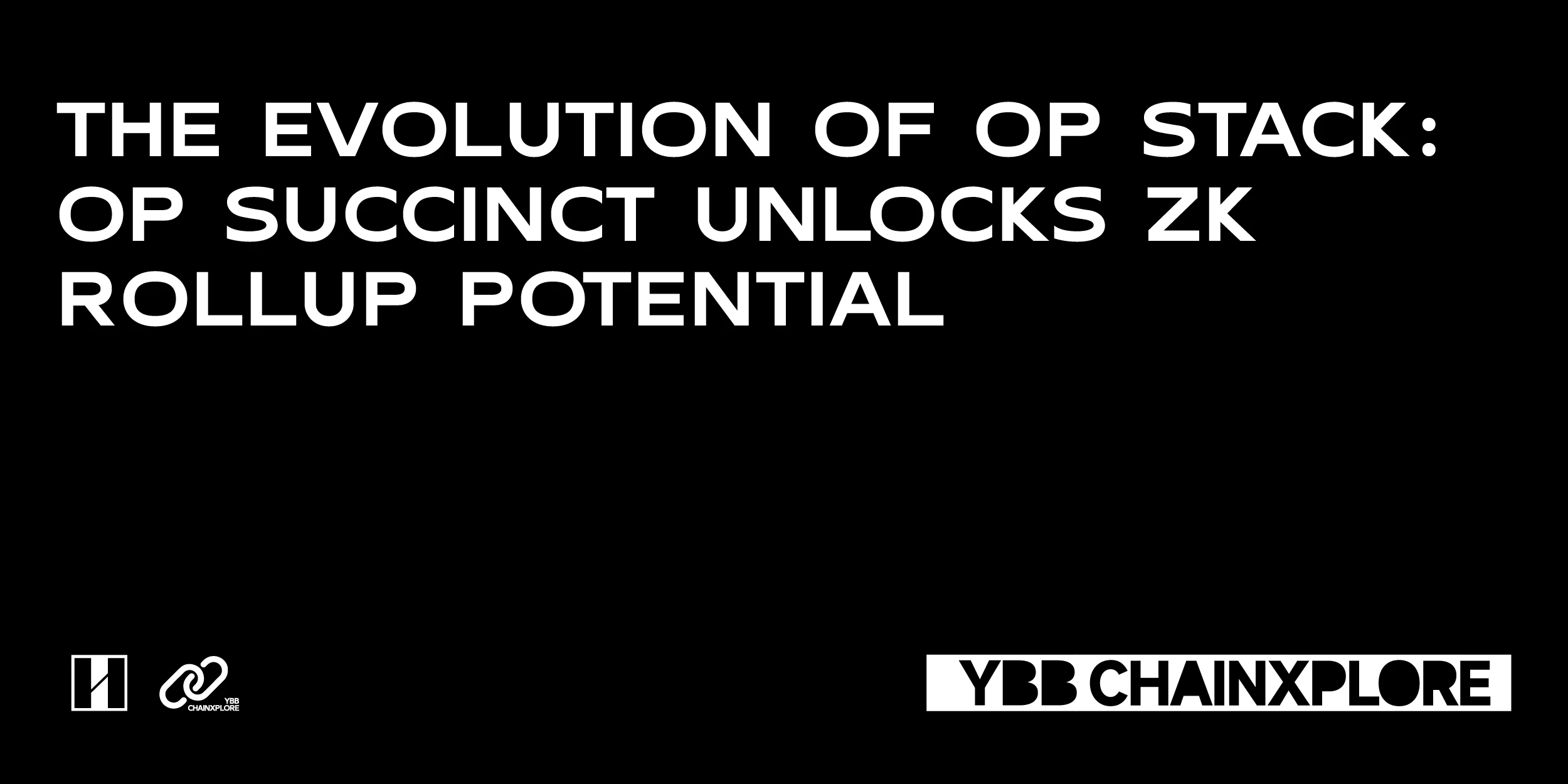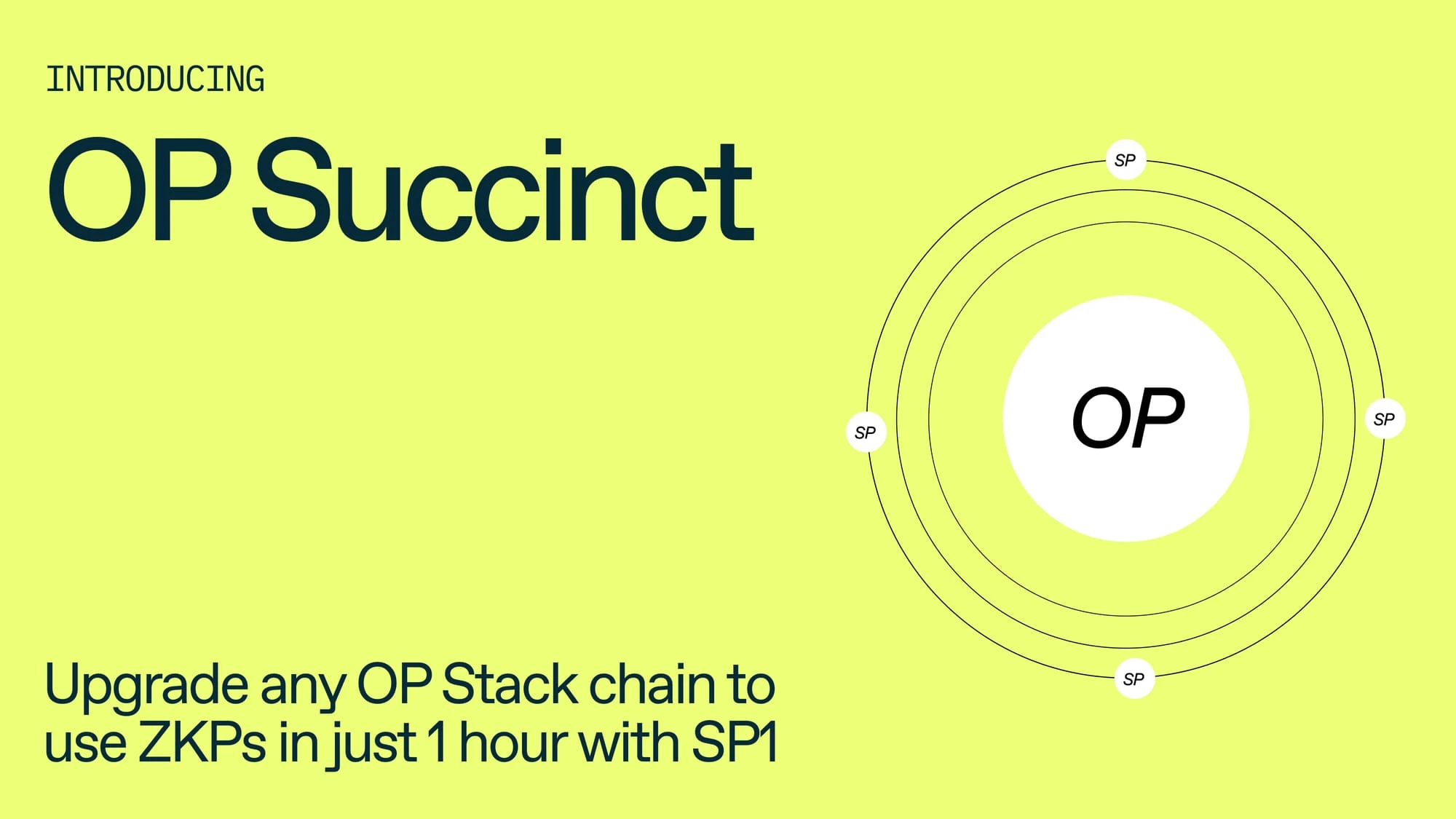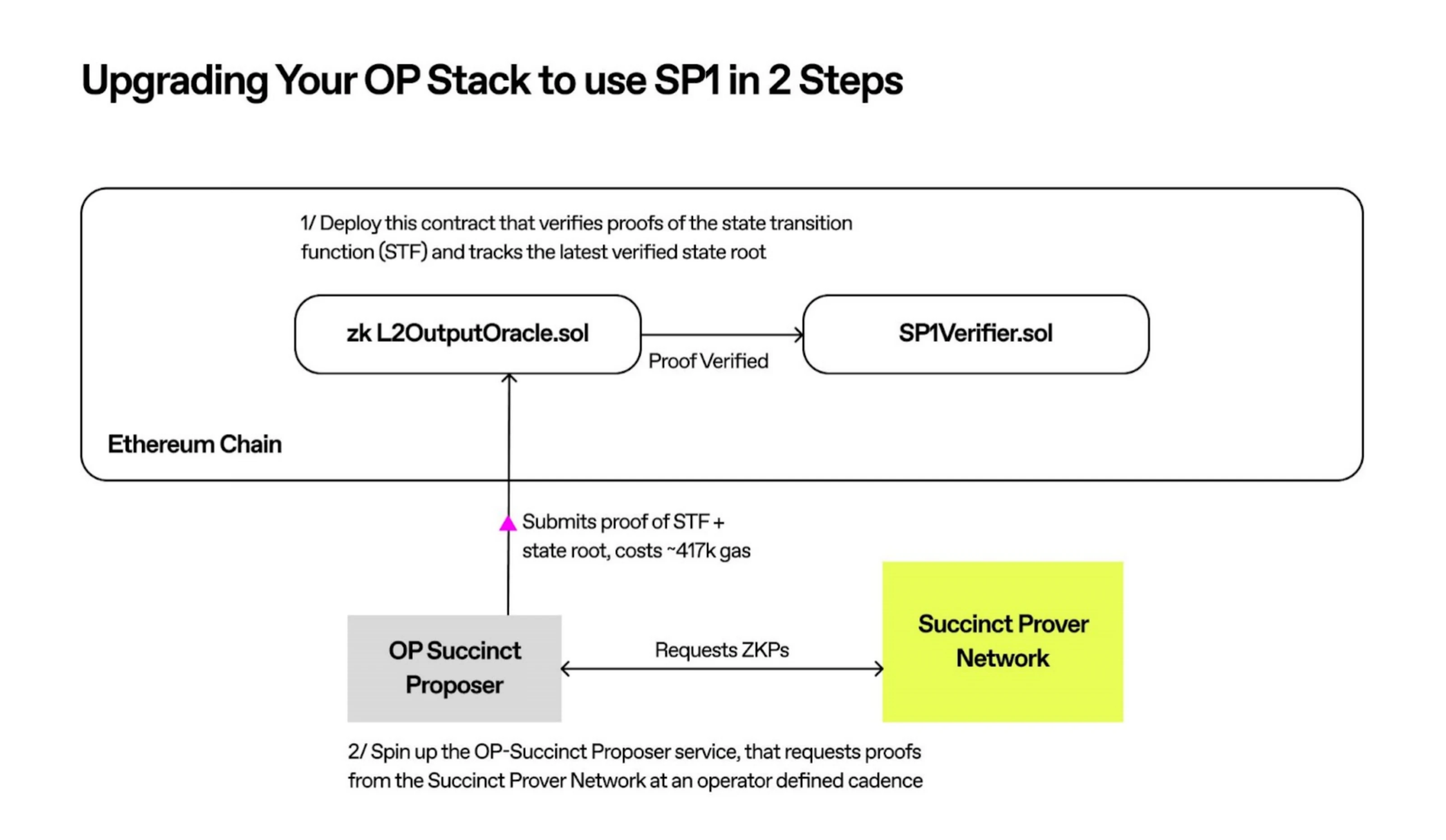原作者: YBB Capital 研究員 Ac-Core
要約
-
The main functionality provided by OP Succinct is to integrate ZKP into the modular architecture of OP Stack to complete the transformation of OP Stack Rollup into a fully verified ZK Rollup;
-
If the ultimate goal of Ethereums future expansion is to convert every Rollup into a ZK Rollup, OP Succinct aims to combine Rust and SP 1 to implement the deployment of OP Stacks Type-1 zkEVM (completely Ethereum equivalent);
-
OP Succinct Proposer mainly completes the parallel generation of proofs and proof aggregation and verification;
-
OP Stacks existing system relies on a 7-day anti-fraud window. If a dispute arises, the transaction verification will be delayed for a week. OP Succinct uses ZK proofs to shorten the time required for transaction completion, eliminating the need to extend the anti-fraud window.
-
OP Succinct can significantly reduce transaction costs.
1. Recent Review: OP Mainnet Status and OP Stack and OP Labs
Image source: Blockscout
1.1 OP Mainnet Recent Development Highlights
According to news on March 30, 2024, OP Labs released the fault proof on the OP Sepoila testnet, and officially released the fault proof on OP Mainnet on June 11, 2024, thereby advancing decentralization to the first stage. It allows ETH and ERC-20 tokens to be withdrawn from OP Mainnet, allowing users to question and delete invalid withdrawals (including Base, Metal, Mode and Zora) without the need for a trusted third party.
To ensure the security and trust of user assets, Optimism uses fault proof to improve the accuracy and effectiveness of on-chain transactions and prevent malicious behavior. The principles include:
-
Data availability: Failure proofs first ensure that all data on Layer-2 is accessible and verifiable by Layer-1;
-
Challenge period: During a certain challenge period, anyone can raise objections to the data on Layer-2.
If someone finds that the data in Layer-2 is inconsistent with the data in Layer-1, they can raise a challenge. Proof submission: If there are objections, the Layer-2 operator needs to submit proofs to refute these objections and prove the correctness of its data; Finality: If there are no valid objections during the challenge period, or the Layer-2 operator successfully refutes the objection, the transaction will be finalized and considered valid.
1.2. The relationship and difference between OP Stack and OP Labs
OP Labs is the team or organization that develops Optimism solutions, and OP Stack is a technical framework for building and expanding Ethereums second-layer network. The relationship between OP Labs and OP Stack can be understood as the relationship between developers and their development tools.
-
OP Labs:
OP Labs is a core contributor to the Optimism project, responsible for developing and maintaining the Optimism second-layer solution. It is a team or organization that focuses on building and improving technical tools related to Ethereum expansion, such as Optimistic Rollups. OP Labs main goal is to reduce the load on the Ethereum mainnet through second-layer expansion solutions, reduce transaction costs and increase transaction speeds. OP Labs also collaborates with other projects such as Succinct Labs to further advance Ethereum expansion technology, such as OP Succinct, which focuses on the optimization of zero-knowledge proofs.
OP Labs is the main team or organization that develops and maintains the Optimism network. Their goal is to build an efficient solution for scaling Ethereum, focusing on reducing transaction fees and increasing transaction speeds. Not only are they responsible for the development of Optimistic Rollups, they are also actively promoting new technologies related to zero-knowledge proofs, such as OP Succinc in collaboration with Succinct Labs.
-
OP Stack:
OP Stack is a modular architecture or technology stack for building and expanding Ethereums second-layer network. It consists of multiple customizable components that allow developers to build their own second-layer chain (Layer 2 Chain) according to specific needs. It provides a standardized way for developers to quickly build a second-layer expansion network that meets specific conditions.
OP Stack is a modular framework developed by OP Labs. This framework provides the infrastructure for building a second-layer network, and developers can use OP Stack to quickly build different extended networks. Due to the modular design of OP Stack, it allows users to flexibly choose different verification mechanisms (such as Optimistic Rollups or ZK Rollups) to meet the needs of different projects.
OP Labs can be understood as the developer of OP Stack, which is a technical tool provided by OP Labs to help developers build and expand Ethereums second-layer network.
Before understanding OP Succinct, you need to understand the four main components of each OP stack: 1. op-geth: obtain transactions from users and use these transactions to generate blocks and execute blocks; 2. op-batcher: batch user transactions and submit them to L1; 3. op-node: read batch data from L1 and drive op-geth for state transition in non-sorter mode; 4. op-proposer: periodically publish output roots to L1 to capture L2 status, which is convenient for processing withdrawals.
2. Succinct Labs and OP Labs work together to inject ZK elements into OP Stack
Image source: Succinct blog
2.1 OP Succinct Architecture
Combined with the content at the end of Section 1.2 above, The Four Main Components of OP Stack, OP Succinct is a lightweight upgrade of OP Stack, allowing the chain to use only blocks verified by ZK while keeping the other three components unchanged (op-geth, op-batcher, and op-node). OP Succinct mainly consists of the following four components:
-
Range Program: This is a program that executes batches of blocks. It is written in Rust and is designed to be executed in zkVM.
-
Aggregation Program.: Aggregates proofs of scoped programs to reduce on-chain verification costs. This program is also written in Rust and is designed to be executed in zkVM.
-
OP Succinct L2 Output Oracle.: A Solidity smart contract containing an array of L2 state outputs, where each output is a commit to the L2 chain state. This contract already existed in Optimisms original system, but was modified to use proof of verification as the authentication mechanism;
-
OP Succinct Proposer: Observes batches of transactions published on L1 and controls proofs for range programs and aggregation programs.
2.2 What kind of Ethereum expansion narrative does OP Succinct tell?
zkEVM Rollup is very difficult to build due to the deep cryptographic expertise required. The OP Labs team has taken into account the proof of support for various validity mechanisms when building the modular OP Stack, and has open-sourced Kona (see extended link 1) to implement the state transition function STF (functional logic of transaction state transition) under OP Stack Rollup through Rust, and finally use Kona and SP 1 programs to generate OP Stacks zero-knowledge proof (ZKP), which means that in theory all chains of OP Stack can be upgraded and ZKP can be used.
The goal of SP 1 (Succinct Processor 1) is to enable any developer to seamlessly integrate Type-1 zkEVM rollup using standard Rust code, and to seamlessly upgrade any existing OP Stack chain to Type-1 zkEVM rollup in just 1 hour through OP Succinct, and provide the high performance required by the application. This will provide the following advantages:
-
Fast confirmation of ZKP: shorten the proof delay to tens of minutes, replacing the 7-day fraud proof challenge period;
-
Reduce costs and increase efficiency: the average cost of each transaction is as low as a few cents;
-
Switching OP Stack to ZK: Simply deploy a smart contract and start a lightweight OP Succinct proposal service (see below) to generate proofs through API calls (including batch processors/sequencers, op-nodes, indexers, etc.);
-
Type-1 zkEVM: All tools and smart contracts compatible with OP Stack Rollup are applicable to OP Succinct Rollup;
-
Improve scalability: Use customizable OP Succinct rollup to add new precompilations and modify the Rollup logic.
According to the official GitHub introduction, the process only requires the installation of Rust, Foundry and Docker to upgrade any existing OP Stack rollup to Type-1 zkEVM rollup, and the process is simplified to only two steps: 1. Deploy the ZK L2 OutputOracle.sol contract; 2. Start the OP Succinct proposal service (see GitHub extension link 2 for the process).
Upgrading OP Stack Rollup to ZK Proof, Image source: Succinct blog
2.3 Building Type-1 zkEVM using SP 1 Reth
Succinct believes that the future of EVM Rollup is a maintainable zkEVM written in Rust. Currently, OP Rollup faces three main problems: a long 7-day fraud proof window, complex interoperability, and a mechanism that relies on multiple sets of data instead of fraud proofs in some cases. In addition, creating zkEVM is a long process, so SP 1 was developed to solve these problems.
SP 1 is a high-performance, 100% open source and fully open source customized zkVM that can verify the execution of any Rust (or LVM compiled language) program. According to public data, OP Succinct Stack has been successfully run on OP Mainnet, OP Sepolia and Base chain, and achieved a proof cost of $0.01-0.02 in Ethereum transactions (see extended link 3). It is hoped that all blockchain infrastructure (including Rollup, bridges, coprocessors, etc.) will be written in Rust (or other LLVM compiled languages) and utilize ZKP in the future.
According to the Succinct blog and open source GitHub content summary, the performance difference between SP 1 and other zkVMs is mainly caused by several key factors:
-
Precompilation-centric architecture: SP 1 supports a flexible precompilation system that can significantly accelerate multiple operations (such as secp 256 k 1 and ed 25519 signature verification, sha 256 and keccak 256 hash functions), reducing the number of RISC-V cycles for many programs by 5-10 times. Its design goal is to provide performance comparable to ZK circuits while maintaining the flexibility and good developer experience of zkVM;
-
Fully open source: SP 1 is 100% open source, allowing teams like Argument and Scroll to implement custom precompilers, significantly reducing cycle counts and speeding up proof generation time;
-
Industry Standard: Since its introduction, the concept of precompilation within zkVM has become an industry standard, integrated into projects such as RISC 0, Valida, Nexus, and Jolt. SP 1 is the only production-ready zkVM with extensive support for precompilation of important cryptographic operations;
-
Efficient memory read and write: SP 1 uses an innovative memory proof method to achieve consistent memory for multiple proofs using a single challenge, avoiding the overhead of Merkle-ized memory.
-
Basic efficiency optimization: Lower blow-up factors and new generation lookup parameters (such as LogUp based on logarithmic derivatives), as well as FRI variants in Plonky 3, improve the utilization of tracking areas.
Image source: Succinct blog, see extended link 4 Appendix Notes
3. Can OP Succinct become the trump card of OP Stack against ZK Stack?
Image source: @jtguibas
If Ethereums expansion plan looks at OP in the short term and ZK in the long term, assuming that OP Succinct can succeed, it will be regarded as an important milestone in Ethereums development path. OP Succinct provides an upgrade path for ETH Rollups to switch from optimistic verification to zero-knowledge proof, which not only reduces transaction costs and increases transaction speed, but also retains the security and anonymity properties of ZK rollups, bringing new possibilities for the future outbreak of the application layer.
Among the four recognized Layer 2 kings, OP Stack is slightly better than ZK Stack in terms of project ecosystem development at this stage. The Matthew effect may become more apparent in the future. With the addition of OP Succinct, it has also siphoned the traffic and potential of ZK Stack to a certain extent. If OP Succinct can be realized in the future, it may also have a certain impact on the traditional zkEVM Rollup.
However, according to the content publicly stated at this stage, it is not difficult to find from the operating logic of OP Succinct that how to ensure that developers can promptly discover the systemic risks caused by unknown vulnerabilities when modifying STF functions or adding new precompiled functions requires our long-term attention.
拡張機能リンク:
(1) https://github.com/anton-rs/kona?ref=blog.succinct.xyz
(2) https://github.com/succinctlabs/op-succinct
(3) https://blog.succinct.xyz/sp1-reth/
(4) https://blog.succinct.xyz/introducing-sp1/
This article is sourced from the internet: OP Stack鈥檚 Advanced Path: OP Succinct Unlocks the Potential of ZK Rollup
関連:マルチコインのインタビュー「なぜETHのダウンはひどいのか?」へのコメント:イーサリアムのビジョン、開発の道筋から現在の問題まで
Original author: @Web3 Mario (https://x.com/ウェブ3_mario) Last Sunday, I read an interview with Bankless and Multicoin titled Why is ETH Down so bad? and found it very interesting and profound. I recommend that you read it. Ryan fully demonstrated the difference between Web3 pragmatism and fundamentalism in the interview, but I have already discussed this in detail in previous articles. In addition, the views in the interview also triggered a lot of inspiration and thinking for me. Indeed, in recent times, Ethereum has begun to suffer a certain degree of FUD. I think the direct reason is that the passage of the ETH ETF did not trigger a similar market as the passage of the BTC ETF, which triggered some people to rethink the vision and development direction of Ethereum. I…













